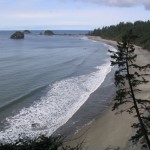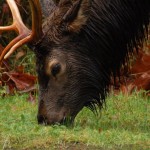WHAT
Everyone wants to see wildlife, and Olympic National Park has plenty to offer. That said, there is no guarantee that a specific animal will be seen. The Park is nearly a million acres in size, and over ninety percent of it is wilderness well off the beaten track.  Most animals prefer the solitude that this isolation provides, but a few—like black tail deer, grey jays, ravens, chipmunks, banana slugs and sometimes elk—make themselves available for a starring role in home videos. By contrast, beaver, porcupine, and cougar are rarely seen, either because they are few in number—like the first two—or are wily and smart enough not to be seen even when nearby, like cougars. Some examples between these extremes are black bear, river otters, brown rabbits, bobcat, grouse and coyotes.
Most animals prefer the solitude that this isolation provides, but a few—like black tail deer, grey jays, ravens, chipmunks, banana slugs and sometimes elk—make themselves available for a starring role in home videos. By contrast, beaver, porcupine, and cougar are rarely seen, either because they are few in number—like the first two—or are wily and smart enough not to be seen even when nearby, like cougars. Some examples between these extremes are black bear, river otters, brown rabbits, bobcat, grouse and coyotes.
WHEN & WHERE
Very few visitors leave the Park without having seen some of its wildlife. Follow these tips and the chances of a sighting improve:
- Visit the Park in the hours just after dawn and just before dark.
- Explore the trails that don’t have a lot of use.
- Be as quiet as possible.
Animals, for the most part, conserve energy by reducing their activity in the heat of the day. They protect themselves by avoiding people and noises that they are not accustomed to. Foraging is a behavior that directly relates to their survival, and knowing a little bit about when they forage and what they eat can be useful. Some examples are:
- Bears eat more vegetation than one might think and they like their food fresh, such as newly sprouting plants. They follow the Park’s “spring” by foraging in the lowlands from the time they come out of semi-hibernation in March, move to the mid-elevations in April and early May, and move to the higher elevations from late May through the fall.
- Deer and elk are browsers. They move around a lot and nibbling here and there.
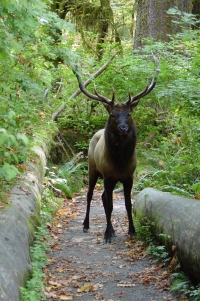 Their preferred diet is one composed of twigs and leaves from trees and bushes, and grasses. So if there has been recent browsing of these plants, it’s likely that these animals have already come and gone.
Their preferred diet is one composed of twigs and leaves from trees and bushes, and grasses. So if there has been recent browsing of these plants, it’s likely that these animals have already come and gone. - Birds of prey, like hawks, hunt when their food sources (often rodents) are active at both ends of the day. Eagles and osprey snatch fish from quiet river pools that are uncrowded by trees, and lakes, when the fish are likely to be feeding on flying insects over the water’s surface. (Fish leaping out of the water is a good sign that they are actively feeding.)
Looking at the Park Map it’s evident that a very large portion of the Park is well removed from roads or even trails, part of the definition of wilderness. If animals (with a few exceptions) don’t tolerate the presence of people, then it’s to be expected that they generally prefer the isolation that the wilderness provides. 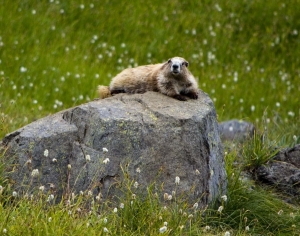 But there is a curious twist to this axiom; the wildlife move all about the Park and often make use of the trails. In fact, many trails were originally animal trails later improved by the Park Service for hiking.
But there is a curious twist to this axiom; the wildlife move all about the Park and often make use of the trails. In fact, many trails were originally animal trails later improved by the Park Service for hiking.
The expectation here is not that visitors strike off-trail into the wilderness. They don’t have to in order to avoid the crowd. Take a short hike (20-30 minutes round trip) on any of these trails to increase the chance of seeing wildlife. (Again, see the Park Map.)
- Follow the Hurricane Hill trail, and after 0.2 miles take a right on the Little River Trail.
- Follow the Hurricane Hill trail, and after 1.2 miles take a left on that portion of the Hurricane Hill trail that leads down to the Elwah (el-wa) valley.
- From the steps of the Storm King Ranger Station follow the trail toward Marymere Falls, and after 0.4 miles, before crossing Barn’s Creek, take a left on the Barn’s Creek Trail.
- At the end of the Sol Duc (sol-duck) Road follow the trail 0.7 miles to a fork just short of the Sol Duc Falls, and then take a left on the Sol Duc Trail.
- Beyond the nature trails at the end of the Hoh (ho) Road, follow the Hoh River Trail.
- Turn left, headed south on US101 at either the Queets River Road (N47.53 4458, W124.22 3017) to the lower Queets Road, or the West Boundary Road #21(N47.48 8499, W124.09 6532). Referring to the Park Map, follow 21 to 2180 to 2180-010 to 2100 to the upper Queets Road.
- From the Graves Creek Campground northeast of Lake Quinault, follow the Quinault River Trail.
WHAT & WHY NOT TO DO IT
With the exception of mice, raccoons, and possibly bears raiding a camp site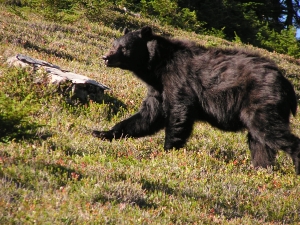 while backpackers are off enjoying the Park, there have been very few adverse encounters between visitors and wildlife. Most of the credit goes to the animals; they are adverse to close contact with humans. But credit must also be given to visitors who follow these simple precautions:
while backpackers are off enjoying the Park, there have been very few adverse encounters between visitors and wildlife. Most of the credit goes to the animals; they are adverse to close contact with humans. But credit must also be given to visitors who follow these simple precautions:
- Never Feed The Wildlife, Not Once , Not just A Little, Not Because it’s Organic and GMO Free. Just Don’t Do It!
- Keep plenty of distance between you and all animals, and remember that most are capable of out-running you if they choose to (elk can sprint to speeds in excess of 45 mph).
- If you want a close-up, bring a long lens.
- If an animal stops what it is doing, doesn’t go back to that activity and stays focused on you, move quietly and slowly away.
- Most animals are shy; if they move away do not follow them.
- If an animal blocks your way, move away and find something else somewhere else to do for the rest of the day.
- Never, ever attempt to shoo away or scare wildlife.
Animals have the same fight or flight instinct that humans do, honed to perfection from living in the wild. Corner an animal or lead them to the conclusion that they are being stalked or pursued, and they are hardwired to fight, if they feel they can’t escape, in order to preserve themselves. With the exception of slugs and a few others, they have the upper hand; it’s their home territory and their fight to win, if it should come to that. Do your part to make sure they don’t have to exert any excess energy on you.
With regard to the title of this page:
- The fastest in the Park are Peregrine falcons, with dive speeds in excess of 200 mph, the fastest animal of all.
- The furriest are the Sea Otters, with a coat that has a million hairs per square inch, making them the furriest of any animal anywhere.
The following websites provide much more information on the animals in the Park.

